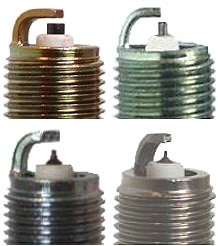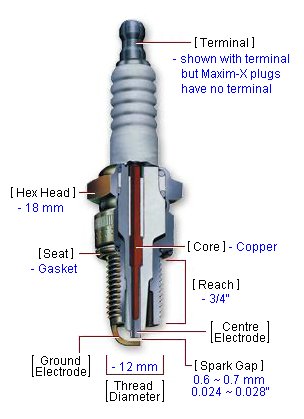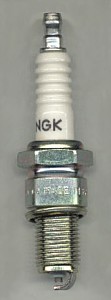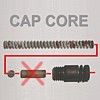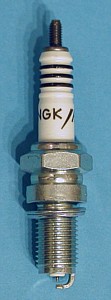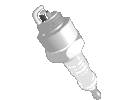 
Maxim-X Spark Plugs |
|||||||||||||||||||||||||||||||||||||||||||||||||||||||||||||||||||||
|
1) Maxim-X Spark Plug Construction? Below you'll find a picture showing the construction and dimensions of a typical Maxim-X spark plug.
2) Which Plugs Were Stock in 1985? In 1985, Yamaha installed non-resistor type spark plugs in the Maxim-X. They recommended either NGK D8EA or Nippon Denso X24ES-U plugs which had the following characteristics:
3) Which Plugs Were Stock in 1986? In 1986, Yamaha installed 5 K
4) Why Different Plugs in '85 vs '86? There has been much discussion about the reasoning behind Yamaha's change from non-resistor spark plugs for the Maxim-X in 1985 to resistor spark plugs in 1986. Usually, the introduction of resistance into the ignition system is necessary to reduce RFI (Radio Frequency Interference) but that problem had already been resolved for the Maxim-X. In both 1985 and 1986, the Maxim-X came equipped with resistor-type spark plug caps (aka covers) so there would have been no need to introduce resistance by way of different spark plugs. So why was the 1986 Maxim-X equipped with both 5 K
After seeing the Maxim-X in service for only a year, Yamaha discovered (whether by testing or customer feedback of some kind is unknown) that the 1985 Maxim-X seemed to be prone to spark plug fouling. At the time they didn't know why, but they did know that using hotter spark plugs would help solve the problem. However, a full heat range increment (an additional 70°C / 158°F or so) wasn't wanted because it impacted performance and engine component longevity, so Yamaha opted for less. The original 1985 NGK D8EA spark plugs had a heat rating of 8 so rather than jumping to the next hottest full heat rating (7) by installing D7EA spark plugs (which were available), Yamaha decided on only a half heat range temperature increment. In effect, they wanted a spark splug that would be equivalent to a D[7.5]EA but NGK didn't produce such a spark plug... at least not in a non-resistor format. To get the half heat range increment they were looking for, Yamaha had little choice but to use what was available and that turned out to be the NGK DR8ES-L spark plug which was then used in 1986 models (the "L" indicates a half heat range as shown in the NGK Spark Plug Designation Key) . Whether the spark plug temperature increment had the desired effect was never formally evaluated before production of the Maxim-X stopped. It may have been beneficial but might also have been harmful - no one knows. That part of the mystery of the different plug types will have to remain unsolved. 5) 20+ Years of Hindsight! Yamaha's decision to switch spark plugs may have been completely logical and appropriate at the time but they didn't have the benefit of 20+ years of hindsight. The past two decades have revealled another issue related to the the Maxim-X spark plugs which shouldn't simply be ignored.
With the passage of time it has become abundantly clear that the Maxim-X ignition system isn't all that powerful and doesn't stand the test of time. The coils, the spark plug wires, the plug caps and the spark plugs each contribute, in one way or another, to making the Maxim-X ignition system troublesome, particularly in moist weather... and much of it relates to increased secondary resistance at various points between the coils and the spark plugs. Ideally, ignition systems shouldn't have these problems but the reality is that after 20+ years, they all do to one degree or another, and that's what may have been overlooked when the decision was made to install resistor spark plugs in 1986 models. For some Maxim-X owners, time has revealled that an additional 5 K This sort of thing has happened and I'm sure it will happen again but it doesn't mean that one set of spark plugs was better than the other, not at all. In this example it just so happens that the ignition system already had as much resistance as it could bear before the addition of the resistor plugs. Adding that extra resistance tipped the scale and increased the secondary resistance to a point that was too much for the inferior stock coils to push a spark through. Going back to the original plugs reduced the resistance just enough to allow a spark to get through and do its job. I'll be the first one to tell you that this is not the correct way to deal with your ignition problems. Plug caps can be repaired, connections improved, plug wires replaced, coils upgraded.... all of which would be infinitely better and would have a much greater effect on the reliability of the spark. But, again, the reality is that not everyone is mechanically inclined and not everyone has a pocket full of cash to spend on ignition components (if they even realize that it's an ignition problem). This simply isn't something that most people will have to worry about but if you're not an expert, consider this: If your Maxim-X still has the stock coils and you're uncertain about the condition of the rest of the ignition system, then err on the side of caution by installing non-resistor NGK D8EA spark plugs as Yamaha did in 1985, or use an equivalent D8EA substitute. It'll improve your odds of getting the bike on the road without too much cost and effort... albeit slightly. With any luck, the spark plug fouling which Yamaha was concerned about won't effect you but if it does, fouled plugs are much easier dealt with than a problematic igntion system. 6) Iridium Plugs - A Better Choice! Whether your ignintion system is problematic or not and whether your carbs are tuned well or not, Iridium spark plugs will always be a better choice. If you can afford them, then by all means, buy them. They'll improve starting and bottom end responsiveness. They require less voltage to fire, generate a bigger and more powerful spark and lessen the likelihood of misfiring. And, they're not as susceptible to fouling and rarely need replacing. As far as I'm concerned, they're a must for anyone with a Maxim-X.
Unfortunately, Iridium spark plugs cost quite a bit more than traditional spark plugs and they're not readily available either. Where I live in Ontario, Canada, both Napa and Canadian Tire sell NGK DR8EIX Hyper Iridium spark plugs (the ones for the X) for the outrageous sum of CAD $14.81 each ($12.99+14% taxes). No one else in the area seems to carry them and even Napa has to order them in. As you can see from the spark plug cross reference information, there just aren't that many manufacturers that produce Iridium spark plugs - in fact, there are only two that I know of with Iridium plugs for the Maxim-X. However, if you're fortunate enough to live in the U.S.A., you'll have some notable benefits. First, U.S. prices for Iridium spark plugs are a lot lower (in the order of USD $7.00) and ordering/shipping is much easier as well. Just about anyone in the U.S. could order NGK DR8EIX Iridium plugs from www.SparkPlugs.com for only USD $7.32 each (September 09, 2007 price) and depending on where you order, shipping within the U.S. might even be free. Needless to say, the cost of a full set of Iridium spark plugs for the Maxim-X is a lot more manageable south of the border.
If your Maxim-X has a hard time starting; if it has a rough idle; if the throttle is especially twitchy at low RPMs or if bottom end performance is poor; bite the bullet and spend the money on a set of Iridium plugs. They won't solve all your problems but they'll certainly bring you a step closer to your goal. If you simply want to improve already good performance, Iridium spark plugs will likely do that for your Maxim-X too. You won't be disappointed.
7) Spark Plug Gap - CAUTION For both 1985 and 1986 model spark plugs, the Maxim-X service manual specifies:
Since the stock coils are so often a problem and since time takes its toll and adds resistance throughout the secondary ignition circuit, I usually recommend tending toward the lower end of the specified gap range - typically 0.60mm to 0.65mm (0.024" to 0.026"). That often helps minimize the likelihood of misfiring where ignition systems aren't up to par.
To achieve the propper gap, you'll undoubtedly start tapping the outer electrode and prying against the centre electrode as we all do. That's fine for the stock spark plugs but it's not fine for Iridium spark plugs.
If you do decide to install Iridium spark plugs (highly recommended), you should heed these words of caution: Iridium is an extremely hard and extremely brittle material. If you pry against an Iridium electrode you will almost certainly cause it to break. That's important to know because NGKs DR8EIX Iridium spark plugs are packaged with a factory set spark gap of 0.76mm (0.030") which exceeds the specification for the Maxim-X spark gap. That means that gapping of the Iridium plugs will be required and if you plan to do the same tapping and prying, you'll almost certainly experience tragedy when you break the centre electrode. In most other cases, it's perfectly fine to carelessly pry against the centre electrode but don't do it with Iridium spark plugs or you may find yourself having to buy new ones.
If you'd like to see more about the hardness of Iridium, the www.SparkPlugs.com web site has some information about Iridium and its relative hardness compared to other spark plug electrode materials. 8) Torque Specification Torquing spark plugs? That's for babies. Real men don't torque spark plugs, do they? After all, how complicated is tightening up a spark plug? Who needs it?... YOU DO - TRUST ME !!!
Spark plug torque specifications are provided for three reasons. The first is to ensure that the spark plugs are sufficiently tight so as not to come loose and possibly blow out. The second is to ensure that there is a good gasket seal against combustion leakage. The third is to ensure that the aluminum threads aren't stressed, weakened or damaged. When you decide to tighten your spark plugs by hand (without adhering to torque specifications), achieving precisely the specified torque value is a virtual impossibility - they'll end up either under torqued or over torqued but never right on spec. The problem is that each time you over torque the plugs, you stress and weaken the aluminum threads in the head. Unfortunately, the effect is cumulative until one day you find yourself stripping the threads or you have the misfortune of blowing out a plug. Think it won't happen? Think again. Plenty of XJ owners have had this happen and then needed to retap the threads to install a helicoil. It's a tragedy that can happen but the good news is that it's completely avoidable by properly torquing the spark plugs each time they're removed and replaced. Like every good plan, however, there's a catch. Yamaha didn't provide the best tools for the job in the Maxim-X tool kit. The spark plug tool provided in the kit in 1985 could only be turned by a steel rod for leverage and the tool provided in the kit in 1986 is easily damaged. In order to torque the spark plugs properly, it may first be necessary to buy an appropriate 18mm spark plug socket... but that too can be difficult. You'll find more details about buying an appropriate tool in the SERVICE section entitled Spark Plug Socket. However you accomplish it, these are the torque specifications for the Maxim-X spark plugs: I'm a little more cautious than most so I tend to go to only 90% of the specified torque. That makes me feel a little better about the possibility of an uncalibrated torque wrench. The last thing I want is to pull the spark plug threads out.
9) Plug Diagnosis & Other Info Spark plug diagnosis has been well covered and illustrated by plenty of others so rather than re-inventing the wheel, I decided that it would suffice to provide some external links to various web sites.
|
|||||||||||||||||||||||||||||||||||||||||||||||||||||||||||||||||||||
